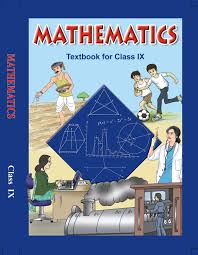Class 9 - Mathematics
Introduction to Euclids Geometry - Exercise 5.1

Top Block 1
Exercise 5.1
Question : 1: Which of the following statements are true and which are false? Give reasons for your answers.
(i) Only one line can pass through a single point.
(ii) There are an infinite number of lines which pass through two distinct points.
(iii) A terminated line can be produced indefinitely on both the sides.
(iv) If two circles are equal, then their radii are equal.
(v) In the Fig. , if AB = PQ and PQ = XY, then AB = XY.

Answer :
(i) False.
Infinitely many lines can pass through a point in different directions.
(ii) False.
Through two distinct points only one line can pass.
(iii) True.
A terminated line or line segment can be produced indefinitely on both sides to give a line.
(iv) True.
Two circles of equal area (i.e., equal circles) will have the same radius from the relation
area = πr2.
(v) True.
From the axiom that if two things are, separately, equal to a third thing, then, they are
equal to each other.
Question : 2: Give a definition for each of the following terms. Are there other terms that need to be defined first? What are they, and how might you define them?
(i) parallel lines (ii) perpendicular lines (iii) line segment
(iv) radius of a circle (v) square
Answer :
(i) Parallel lines : Two straight lines which have no point in common are said to be parallel
to each other.
(ii) Perpendicular lines : If one among two parallel lines is turned by 90°, the two lines
become perpendicular to each other. Parallel lines has been defined before, ‘rotation
through 900 needs further defining. Rotation may be assumed as an intuition therefore,
can not be used.
(iii) Line segment : A line with two end points is a line segment.
‘Line’ and ‘point’ have been defined before.
(iv) Radius of a circle : The line segment with one end point at the centre and the other at
any point on the circle.
‘Centre’ may be defined (assuming inside) as a point inside the circle which is at the same
distance from all points on the circle.
Square : A quadrilateral with all sides equal and all angles right angles is a square.
A quadrilateral is a figure with four sides.
‘Figure’, ‘side’ and ‘angle’ may be assumed known.
Question : 3: Consider two ‘postulates’ given below :
(i) Given any two distinct points A and B, there exists a third point C which is in between A and B.
(ii) There exist at least three points that are not on the same line.
Do these postulates contain any undefined terms? Are these postulates consistent? Do they follow from Euclid’s postulates? Explain.
Answer :
In postulate (i) ‘in between A and B’ remains an undefined term which appeals to our
geometric intuition.
The postulates are consistent. They do not contradict each other. Both of these postulates
do not follow from Euclid’s postulates However, they follow from the axiom given below.
Given two distinct points, thre is a unique line that passes through them.
(i) Let AB be a straight line.
There are an infinite number of points composing this line. Choose any except the two
end-points A and B. This point lies between A and B.
(ii) If there are only two points, they can always be connected by a straight line (From
Euclid’s postulate). Therefore, there have to be at least three points for one of them not to
fall on the straight line between the other two.
Question : 4: If a point C lies between two points A and B such that AC = BC, then prove that AC = AB/2. Explain by drawing the figure.
Mddle block 1
Answer :
Given, AC = CB
Also AC + AC = BC + AC (Equals are added to equals)
BC + AC coincides with AB A C B
⇒ 2AC = AB
⇒ AC = AB/2
Question : 5: In Question 4, point C is called a mid-point of line segment AB. Prove that every line segment has one and only one mid-point.
Answer :
Let there be two such mid points C and D. Then from above theorem
AC = AB/2
and AD = AB/2
So, AC = AD
But this is possible only if D coincides with C. Therefore, C is the unique mid-point. Proved.
Question : 6: In Fig., if AC = BD, then prove that AB = CD.

Answer :
Given : AC = BD
To prove AB = CD.
AC = AB + BC
BD = BC + CD
As AC = BD (given)
⇒ AB + BC = BC + CD ⇒ AB = CD. Proved.
Question : 7: Why is Axiom 5, in the list of Euclid’s axioms, considered a ‘universal truth’? (Note that the question is not about the fifth postulate.)
Answer :
Axiom 5 : ‘Whole is always greater than its part.’
This is a ‘universal truth’ because part is included in the whole and therefore can never be
greater than the whole in magnitude.
